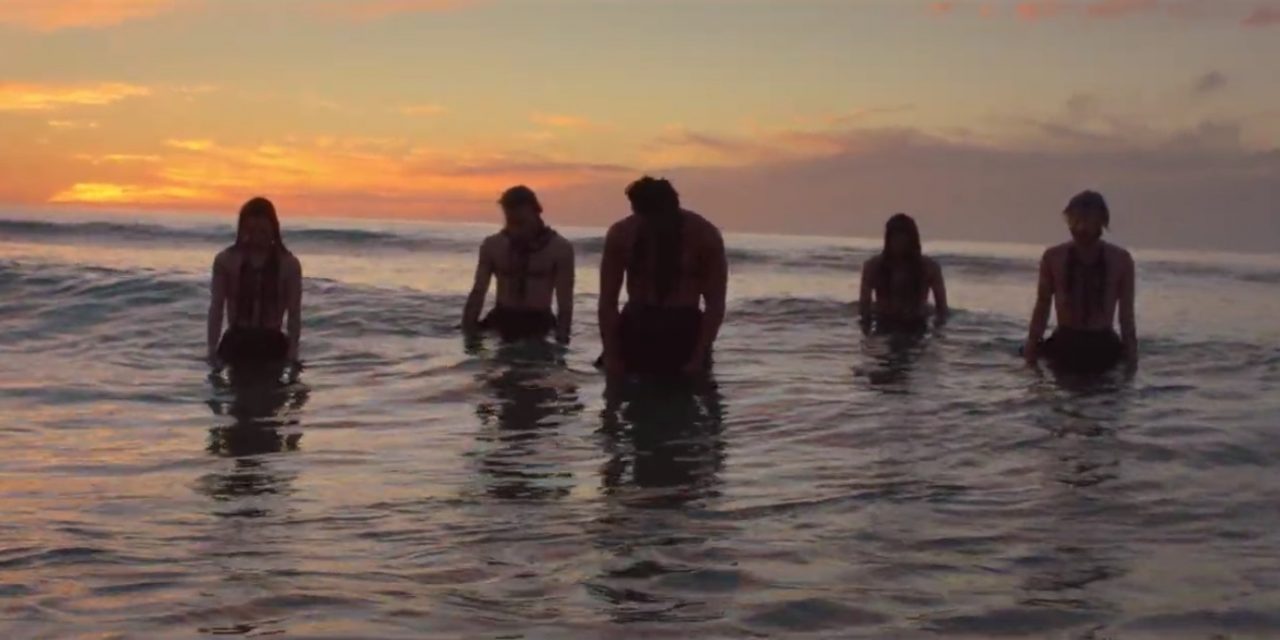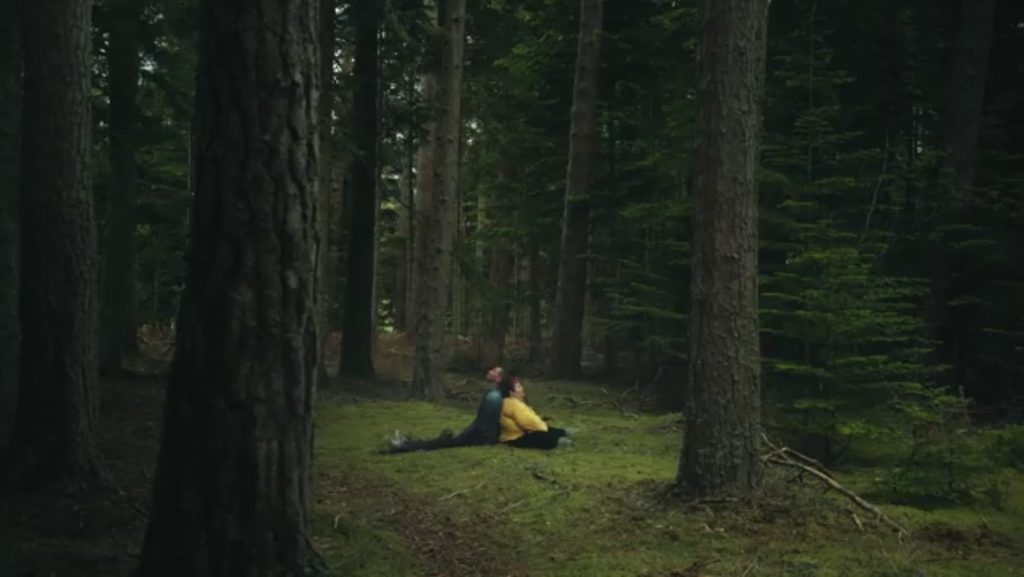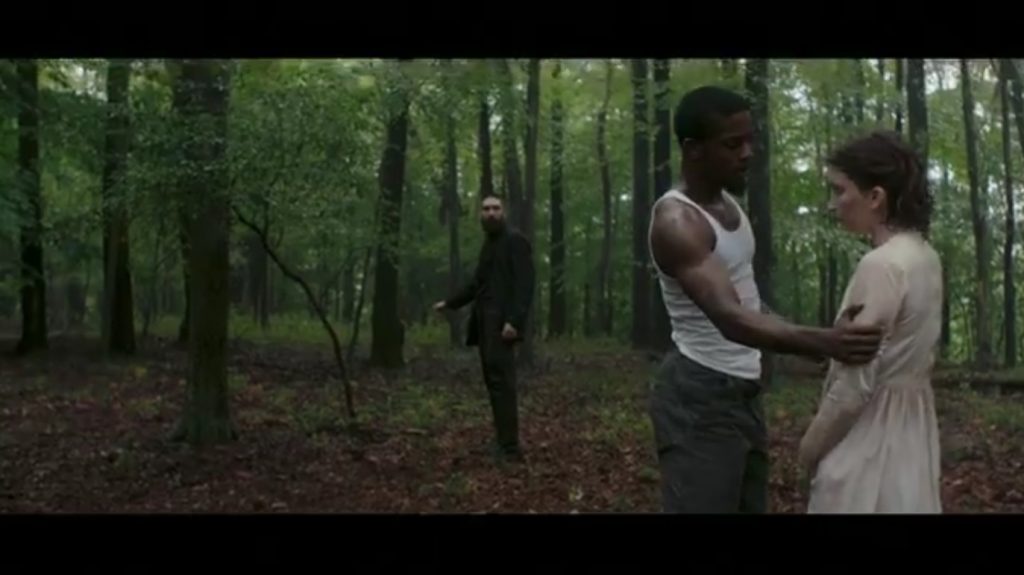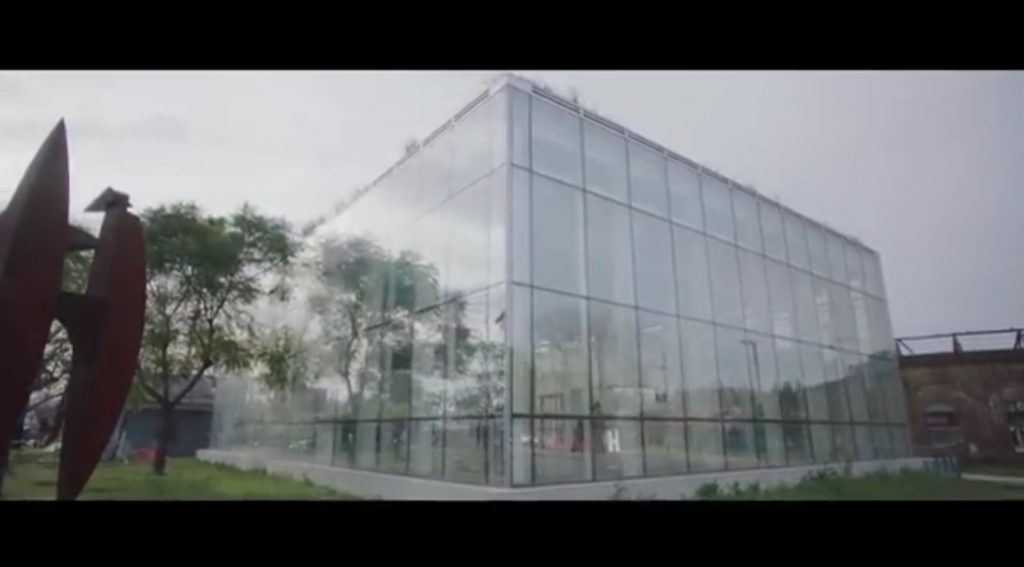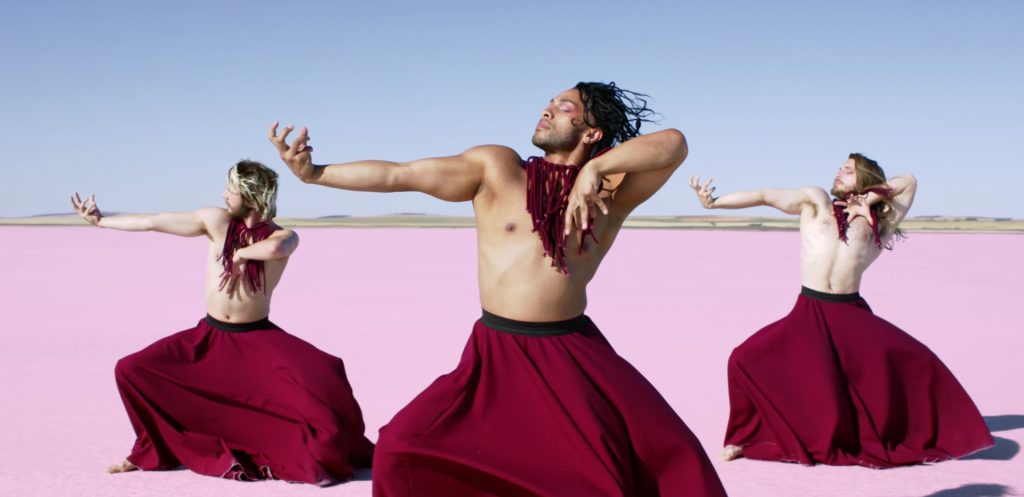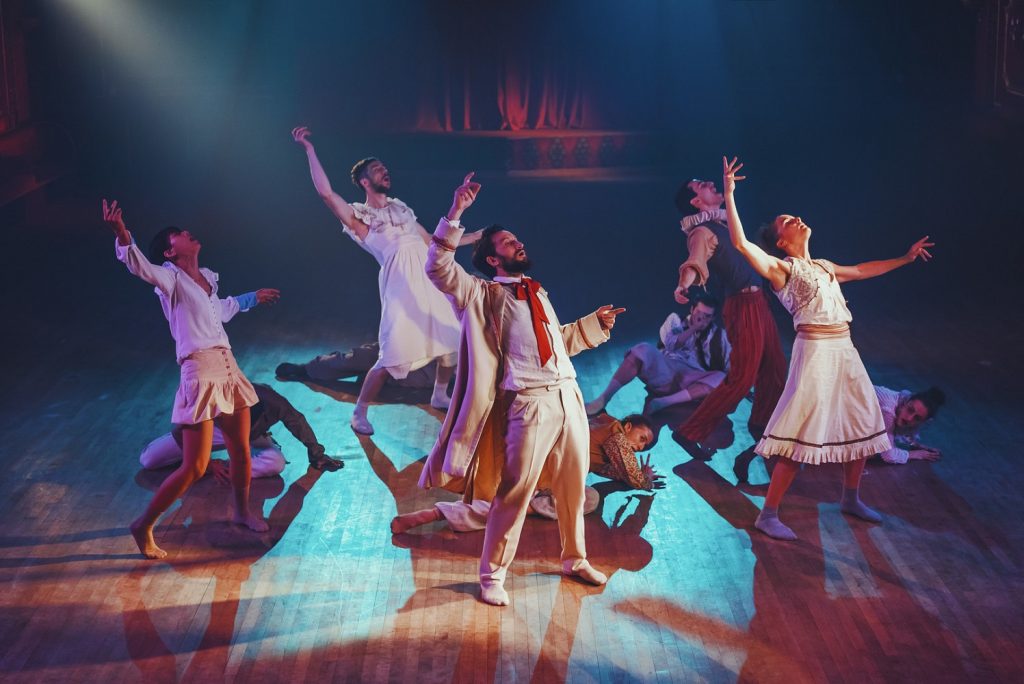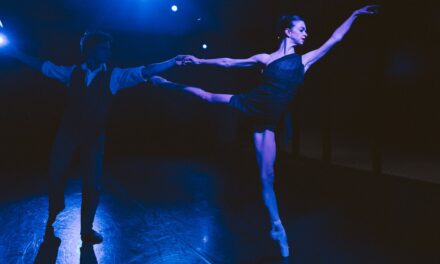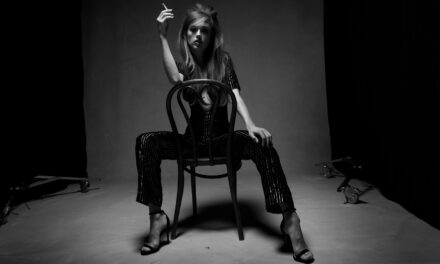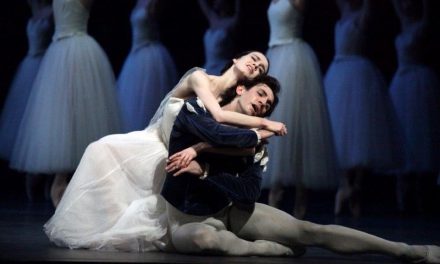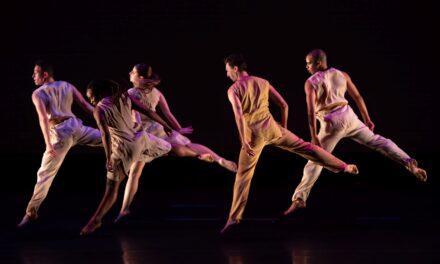This past weekend, The Broad Stage presented Dance Camera West Drive-In – Best of the Festival at the Santa Monica College Bundy Campus – East Parking Lot with two showings each night, January 30 – 31, 2021 . This was the end of the 2021 DCW Film Festival that opened in early January with International Dance: Los Angeles present by Théâtre Raymond Kabbaz. As noted in an earlier article, while DCW’s Executive Director, Kelly Hargraves, was considering different options for presenting the films during the Covid pandemic, The Broad Stage approached her with the drive-in movie idea. Hargraves was thrilled, saying that it was an idea she had long considered.
Dance Camera West Drive-In – Best of the Festival was presented in two programs with eight films on each program. You can read my review of Program A HERE.
Program B began with a very intriguing film titled DUSK (Portugal. 7:52) directed by Henrique Pina, written and choreographed by Olga Roriz, and performed by Magalie Lanriot. A woman (Lanriot) is seen lying alone, troubled. She is then seen running from something or someone. After dashing upstairs to the top of a very modern looking gray building she decides to descend and go outside. Whatever is troubling her cannot be shaken off and we see her drawn up the outside of the building by a cable. Halfway up she begins dancing/moving, even standing on her head. Lanriot literally runs around the outside of the building.
Via the magic of editing, after Lanriot is pulled to the top of the building’s edge we see her actually pull herself onto the rooftop unaided by the cable. After a moment’s pause, she runs full speed toward the opposite side of the rooftop and the camera continues off the edge and into the setting sun. Was being drawn up to the top again that she could not escape herself or her problems and suicide was the only answer for her?
Dusk was presented by Moonway Films, edited by Carolina Caetano and set to original music by composer and sound designer Ricardo Fialho that was dramatic and wonderfully irritating.
One of the highlights of the second program was the brilliantly made film ID (Australia. 5:58) directed, choreographed, edited and costumed by Cass Mortimer Eipper. Featuring members of Transit Dance Company, this short film is fast paced, extraordinarily choreographed and performed. The music score by Alyx Dennison drives the film and slices it up alongside the crisp editing. Although we do not see it, the Steadicam, operated by Paul Malek, causes us to become one of the performers. We move inside, behind, in front of and around the dancers so that we not only observe the work but feel its energy and intensity. Also, adding to the forcefulness of ID is the constant shifting from black and white to color. It sometimes helps build the emotion and other times infuses mystery.
Eipper’s choreography is very physical yet he is not afraid of instilling emotion and his editing skills match these talents. Eipper combines stillness with high energy, observing with being observed and he separates out each dance while keeping them surrounded by the others. This structure presents a brief insight into each dancer’s persona, and while Eipper’s choreographic structure draws from artists who came before him, he definitely has a unique voice. The performers included Kate Arber, Kaitlin Malone, Nikki Tarling, Daniel Jaber, Jayden Hicks, and Lachlan Hall. I loved this film and hope that the Transit Dance Company soon finds its way to Los Angeles.
FOREST FLOOR (United Kingdom. 4:47) is one of those films that warms the heart and leaves one with a sense of hope for humanity. Directed and choreographed by Robbie Synge, we see two friends, one physically challenged, working together to measure and saw numerous squares out of large sheets of plywood. Julie Cleves is confined to a wheelchair, but her friend Synge does not let this stop him from fully including her in his world. These two obviously enjoy one another and share a quiet understanding and humor that is only obtained through trust.
Once the squares are finished, Synge and Cleves travel through the forest, Cleves sitting atop the wood piled in her wheelchair. We see Synge help his friend out of her chair, move down the path in the same manner as she does, and finish with one of the most moving and beautiful contact improv duets that I have seen in years.
Robbie Synge was also the editor of Forest Floor and the gorgeous sound score was created by Jonathon McLoone.
The tone takes a 180 turn with SECOND SEED (United States. 15:43). Directed and choreographed by Baye & Asa, Second Seed is a response to D.W. Griffith’s 1915 silent film “The Birth of a Nation” which was the first motion picture to be screened at the White House. Critic Andrew Sarris wrote about Griffith’s masterpiece: “Classic or not, ‘Birth of a Nation’ has long been one of the embarrassments of film scholarship. It can’t be ignored…and yet it was regarded as outrageously racist even at a time when racism was hardly a household word.”
A woman dressed in a long white dress is seen walking through a wooded area. She is suddenly being chased by what turns out to be people she knows. Jealousies are exposed, relationships altered, betrayals occur and a kind of mayhem takes over. Second Seed moves back and forth from an interior setting to the forest, giving it a sense of time shifting and a place to explore relationships more fully. Racism is introduced through jealousy and portrayal, not discrimination. There is violence, war, death, a wonderful male double solo reflecting emotions of the black and white races, celebration of excess and finally madness. The woman in white? America’s founding innocence and initial dreams perhaps. In the end, she is destroyed from within, not from outside forces.
The incredible performers in Second Seed included Aj Tasley Parr, Marla Phelan, Sam Asa Pratt, Myssi Robinson, and Amadi Baye Washington. The film was edited by Alan Jensen, and Baye & Asa, and the original score that harkened back to the silent movie era is by Jack Grabow.
LOST HORSE (Germany. 3:52) is a self-portrait of a complicated and multi-layered relationship between a woman (Bobbi Jene Smith) and a man (Or Schraiber). It is a movement exploration into the couple’s actual partnership in life . The film comes across as an excellent music video for Israeli singer-songwriter Asaf Avidan’s song by the same title. Avidan wrote that the lyrics were sparked by the disappearance of his horse after it was chased over a cliff by wolves and never found. Those emotions lead to memories of other lost relationships.
The film was choreographed and performed by American dancer, choreographer and actress Bobbi Jene Smith, and Israeli-born dancer Or Schraiber. Both dancers performed with Batsheva Dance Company and their gaga training is evident in the choreography which is very natural and driven by the emotion being expressed. Lost Horse is visually stunning and the two performers are beautiful both as people and as performers. There were no other credits given for the film.
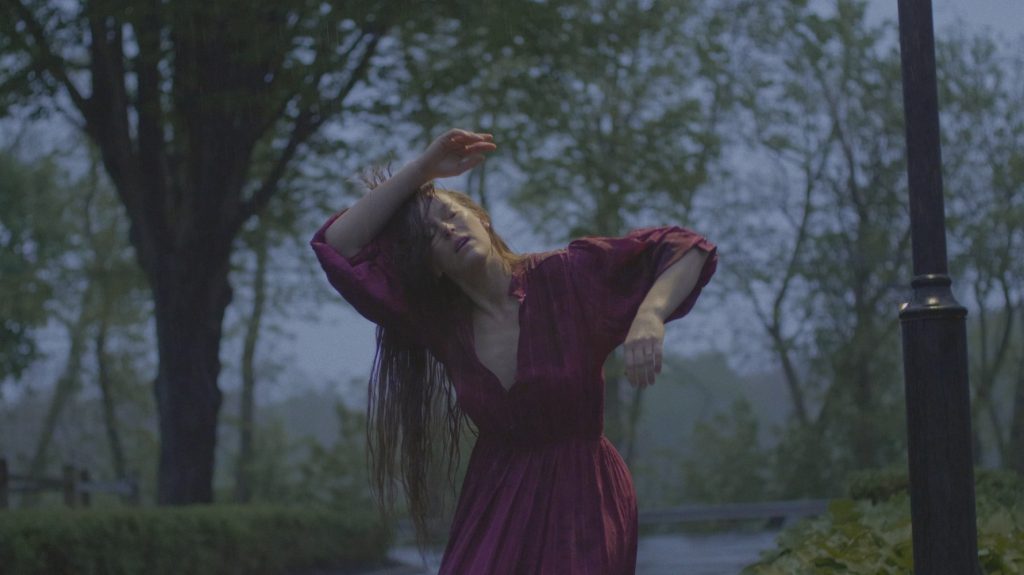
LOST HORSE – Choreographed and Performed by Bobbi Jene Smith and Or Schraiber – Screenshot courtesy of DCW
The weakest film on the program was THE KING (United States. 4:20) a weak tribute to Elvis Presley and the social dancing of that era. Directed and choreographed by Jonathan Redavid, the film is set in a smokey dancehall like venue. Why it is smokey when there are no tables or chairs around or signs of a single cigarette, is a mystery. The only effect is a negative one, simply making it difficult to see the dancing. The man playing Elvis (Chase Benz) does not look like Elvis – more like Bobby Darrin – but does a good job portraying The King. Redavid’s choreography resembles an organized afternoon on the television show American Bandstand set in a large empty room. The action included dancing, screaming young adoring female fans, and male rumbles.
The cast of The King who gave their all and who danced their hearts out included Nick Baga, Deidre Barnes, Adriano Bettinelli, Floris Bosveld, Brittany Calavitta, Chris Castillo, Emily Chamberlain, Charles Fournier, Jason Glover, Gabe De Guzman, Molly Horne, Yoori Kim, Jana Krumholtz, Kayla Radomski, Maria Laura Savio, Lake Smith, Effie Somrova, and Minn Vo. Elvis Fans were played by Diana Change and Tatiana Maricely. Edited by Alex Laya. The music was by The King, Elvis Presley.
If you enjoy dancing or watching the tango, you will love the film BEING (Argentina. 7:13) directed by Destito and Augustina Videla and choreographed by Augustina Videla. The film description reads: “Being captures the restorative power that draws the dancer to the dance. Away from a life of sidewalks and cellphones, where beauty is unnoticed, time stops so it may start again. The dance restores the self, and the senses reconnect with the world, like a flower bouncing back from destruction.” This film definitely hits its target and my only complaint is that I wanted more.
Being follows a beautiful young woman’s trip to a beautiful, glassed in square studio, the rehearsal and her bus ride home. We see her stress before and her renewed energy after time spent dancing with her tango partner and friends. Videla takes a single tango, performed by six couples and transforms it into an amazing group work. She moves the dancers through patterns, lines and other formations without sacrificing the essence or majesty of her luscious tango. Via brief facial closeups and a momentary slow motion effect, we get a sense of the relationship between our main character and her partner; a relationship that the viewers can make their own decisions about.
Social Tango Company included dancers Victoria Scolari, Lucía Ohyama, Constanza Vieyto, Mónica Matera, Marcela Vespaciano, Celeste Matia, Rodrigo Verón, Sebastian Fernández, Mariano Balois, Diego Gauna, Marcos Celentano, and Breno Márquez. The original score was by the Social Tango Orquesta; Costume Design by Pheonia Veloz; Steadicam operator was Pablo Sebastián Villareal, and editors were Marcelo Goobar, Luz López Mañé, Pablo Destito, and Agustina Videla.
THE CIRCADIAN CYCLE (Australia. 16.11) was written and directed by Garry Stewart and filmed in various locations across South Australia on ancestral lands of The Kaurna People, The Nukunu People and The Gawsler Ranges People. It is another luscious visual experience for all of one’s senses, and the score by Brendan Woithe becomes part of the terrain and the indigenous people/creatures we encounter throughout this short film. The use of cameras on drones gives us an extraordinary view of the country and brings to scale how truly small each of us is on this planet.
According to several sources, “The natural cycle of physical, mental, and behavior changes that the body goes through in a 24-hour cycle. Circadian rhythms are mostly affected by light and darkness and are controlled by a small area in the middle of the brain.” The Circadian Cycle moves from sunrise to sunset following the natural cycles of life. There is birth, metamorphosis, predators, mating and death. The costumes, props, music and choreography maintain a focus on animal and plant life as opposed to a look at urban life. It was refreshing to not see a single building or car, or any other signs of the city. The movement itself investigates nature.
Choreography by Garry Stewart and the dancers of The Australian Dance Theatre: Jana Castillo, Zöe Dunwoodie, Harrison Elliott, Thomas Fonua, Christopher Mills, Gabrielle Nankivell, Matte Roffe, Rowan Rossi, and Kimball Wong.
The extraordinarily gorgeous Cinematography was by Cordelia Beresford; the Editor was Mark Bennett; Costume Design and Construction by Davis Browne Design, Georg Meyer-Wiel, Wendy Todd; Props by Marshall Tearle; and Vocals were by Sarah Belkner.
#####
Dance Camera West Best of the Festival Winners were
Outstanding Achievement Awards:
Henrique Pina – Beast/Dusk
Adi Halfin – Earth Odyssey/Lost Horse
Best of Fest Award:
Robbie Synge – Forest Floor
Garry Stewart – Australian Dance Theater – The Circadian Cycle
Best Screen Adaptation Award:
Hofesh Shechter – Clowns (Appeared on the International Dance: Los Angeles presented by Théâtre Raymond Kabbaz January 7-9, 2021)
#####
To visit the Dance Camera West website, click HERE.
To learn more about The Broad Stage, click HERE.
Written by Jeff Slayton for LA Dance Chronicle.
Featured image: The Circadian Cycle – Directed by Garry Stewart – Screenshot by LADC

